NSB102 Assignment: Dementia in Australia and Cultural Safety
VerifiedAdded on 2023/03/17
|11
|3169
|86
Report
AI Summary
This report provides an in-depth analysis of dementia in Australia, examining the prevalence of the disease and its impact on the population. It explores various aspects of healthcare delivery, including primary care and community-based services, as well as institutional care. The report delves into the social determinants of health, particularly poverty, and its influence on dementia rates. Furthermore, it discusses the significance of cultural safety and person-centered care in nursing practice, highlighting the importance of partnering with consumers and addressing issues like racism in healthcare. The analysis draws on research findings and relevant professional codes to provide a comprehensive understanding of dementia management and the need for equitable healthcare practices in Australia. The report also covers the role of nurses in providing care and highlights the importance of cultural safety to ensure better health outcomes for all patients.

Running Head: PROFESSION PRACTICE AND CULTURAL SAFETY 1
Profession Practice and Cultural Safety
Student’s Name
Institution Affiliation
Tutor
Submission Date
Profession Practice and Cultural Safety
Student’s Name
Institution Affiliation
Tutor
Submission Date
Paraphrase This Document
Need a fresh take? Get an instant paraphrase of this document with our AI Paraphraser
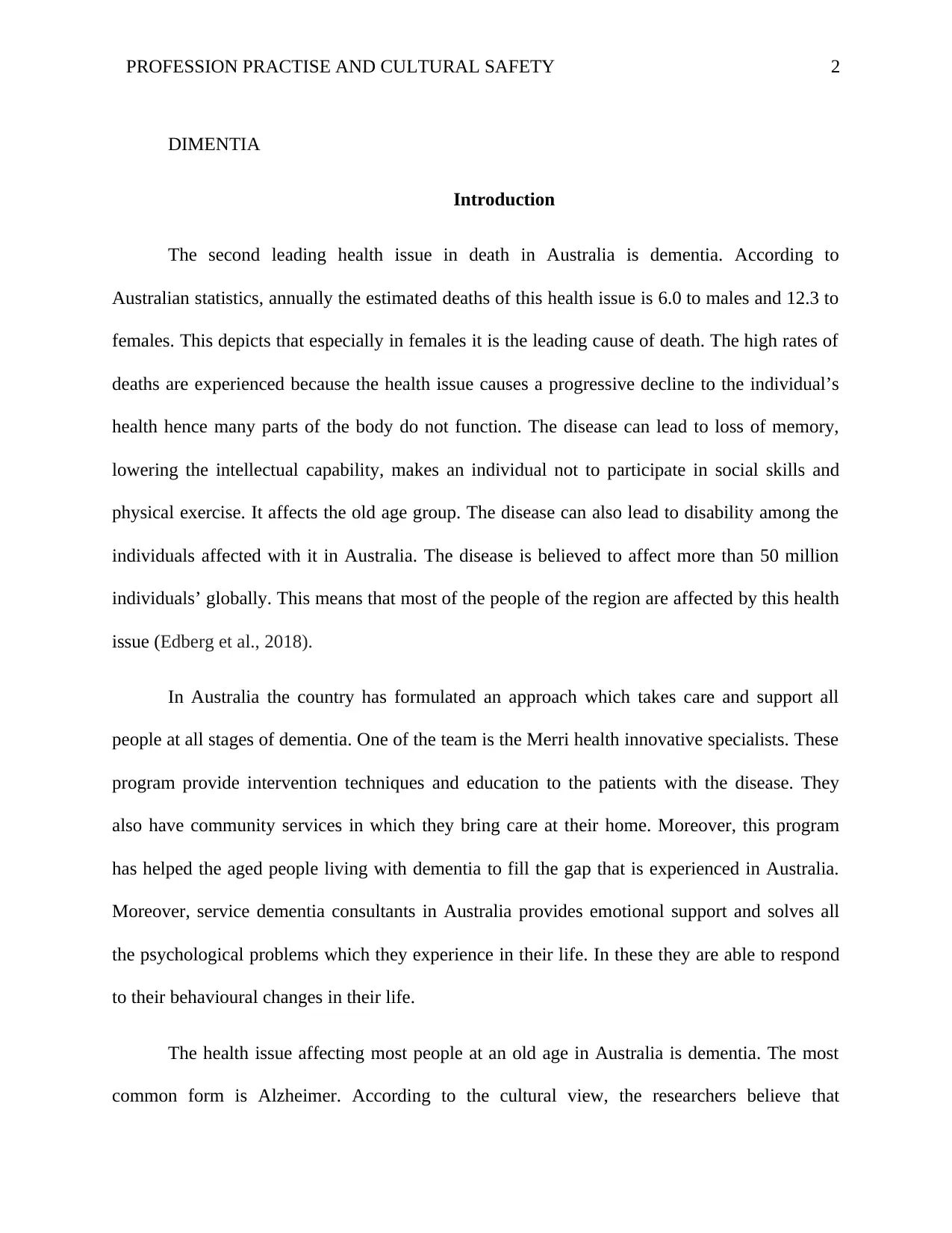
PROFESSION PRACTISE AND CULTURAL SAFETY 2
DIMENTIA
Introduction
The second leading health issue in death in Australia is dementia. According to
Australian statistics, annually the estimated deaths of this health issue is 6.0 to males and 12.3 to
females. This depicts that especially in females it is the leading cause of death. The high rates of
deaths are experienced because the health issue causes a progressive decline to the individual’s
health hence many parts of the body do not function. The disease can lead to loss of memory,
lowering the intellectual capability, makes an individual not to participate in social skills and
physical exercise. It affects the old age group. The disease can also lead to disability among the
individuals affected with it in Australia. The disease is believed to affect more than 50 million
individuals’ globally. This means that most of the people of the region are affected by this health
issue (Edberg et al., 2018).
In Australia the country has formulated an approach which takes care and support all
people at all stages of dementia. One of the team is the Merri health innovative specialists. These
program provide intervention techniques and education to the patients with the disease. They
also have community services in which they bring care at their home. Moreover, this program
has helped the aged people living with dementia to fill the gap that is experienced in Australia.
Moreover, service dementia consultants in Australia provides emotional support and solves all
the psychological problems which they experience in their life. In these they are able to respond
to their behavioural changes in their life.
The health issue affecting most people at an old age in Australia is dementia. The most
common form is Alzheimer. According to the cultural view, the researchers believe that
DIMENTIA
Introduction
The second leading health issue in death in Australia is dementia. According to
Australian statistics, annually the estimated deaths of this health issue is 6.0 to males and 12.3 to
females. This depicts that especially in females it is the leading cause of death. The high rates of
deaths are experienced because the health issue causes a progressive decline to the individual’s
health hence many parts of the body do not function. The disease can lead to loss of memory,
lowering the intellectual capability, makes an individual not to participate in social skills and
physical exercise. It affects the old age group. The disease can also lead to disability among the
individuals affected with it in Australia. The disease is believed to affect more than 50 million
individuals’ globally. This means that most of the people of the region are affected by this health
issue (Edberg et al., 2018).
In Australia the country has formulated an approach which takes care and support all
people at all stages of dementia. One of the team is the Merri health innovative specialists. These
program provide intervention techniques and education to the patients with the disease. They
also have community services in which they bring care at their home. Moreover, this program
has helped the aged people living with dementia to fill the gap that is experienced in Australia.
Moreover, service dementia consultants in Australia provides emotional support and solves all
the psychological problems which they experience in their life. In these they are able to respond
to their behavioural changes in their life.
The health issue affecting most people at an old age in Australia is dementia. The most
common form is Alzheimer. According to the cultural view, the researchers believe that
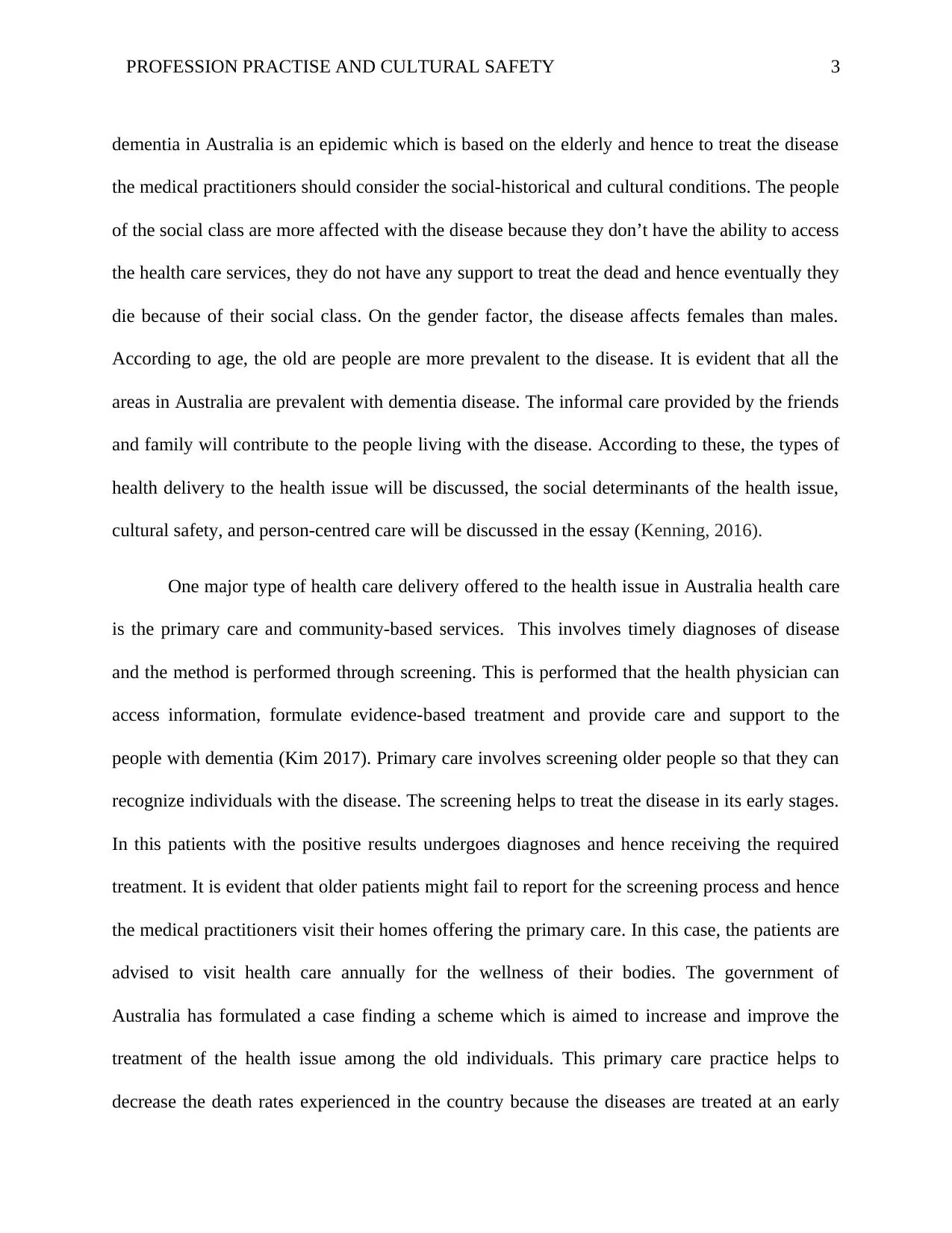
PROFESSION PRACTISE AND CULTURAL SAFETY 3
dementia in Australia is an epidemic which is based on the elderly and hence to treat the disease
the medical practitioners should consider the social-historical and cultural conditions. The people
of the social class are more affected with the disease because they don’t have the ability to access
the health care services, they do not have any support to treat the dead and hence eventually they
die because of their social class. On the gender factor, the disease affects females than males.
According to age, the old are people are more prevalent to the disease. It is evident that all the
areas in Australia are prevalent with dementia disease. The informal care provided by the friends
and family will contribute to the people living with the disease. According to these, the types of
health delivery to the health issue will be discussed, the social determinants of the health issue,
cultural safety, and person-centred care will be discussed in the essay (Kenning, 2016).
One major type of health care delivery offered to the health issue in Australia health care
is the primary care and community-based services. This involves timely diagnoses of disease
and the method is performed through screening. This is performed that the health physician can
access information, formulate evidence-based treatment and provide care and support to the
people with dementia (Kim 2017). Primary care involves screening older people so that they can
recognize individuals with the disease. The screening helps to treat the disease in its early stages.
In this patients with the positive results undergoes diagnoses and hence receiving the required
treatment. It is evident that older patients might fail to report for the screening process and hence
the medical practitioners visit their homes offering the primary care. In this case, the patients are
advised to visit health care annually for the wellness of their bodies. The government of
Australia has formulated a case finding a scheme which is aimed to increase and improve the
treatment of the health issue among the old individuals. This primary care practice helps to
decrease the death rates experienced in the country because the diseases are treated at an early
dementia in Australia is an epidemic which is based on the elderly and hence to treat the disease
the medical practitioners should consider the social-historical and cultural conditions. The people
of the social class are more affected with the disease because they don’t have the ability to access
the health care services, they do not have any support to treat the dead and hence eventually they
die because of their social class. On the gender factor, the disease affects females than males.
According to age, the old are people are more prevalent to the disease. It is evident that all the
areas in Australia are prevalent with dementia disease. The informal care provided by the friends
and family will contribute to the people living with the disease. According to these, the types of
health delivery to the health issue will be discussed, the social determinants of the health issue,
cultural safety, and person-centred care will be discussed in the essay (Kenning, 2016).
One major type of health care delivery offered to the health issue in Australia health care
is the primary care and community-based services. This involves timely diagnoses of disease
and the method is performed through screening. This is performed that the health physician can
access information, formulate evidence-based treatment and provide care and support to the
people with dementia (Kim 2017). Primary care involves screening older people so that they can
recognize individuals with the disease. The screening helps to treat the disease in its early stages.
In this patients with the positive results undergoes diagnoses and hence receiving the required
treatment. It is evident that older patients might fail to report for the screening process and hence
the medical practitioners visit their homes offering the primary care. In this case, the patients are
advised to visit health care annually for the wellness of their bodies. The government of
Australia has formulated a case finding a scheme which is aimed to increase and improve the
treatment of the health issue among the old individuals. This primary care practice helps to
decrease the death rates experienced in the country because the diseases are treated at an early
⊘ This is a preview!⊘
Do you want full access?
Subscribe today to unlock all pages.

Trusted by 1+ million students worldwide
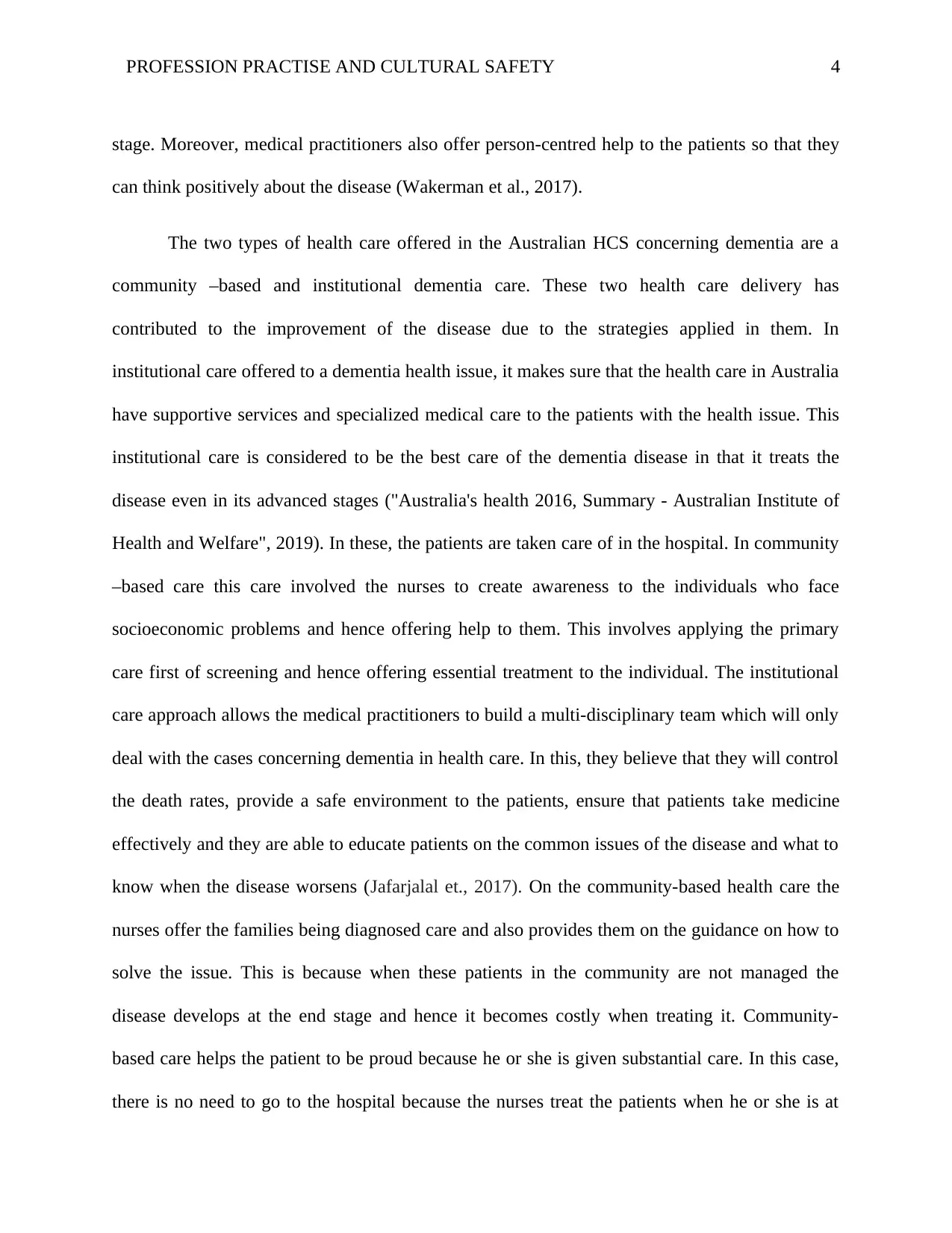
PROFESSION PRACTISE AND CULTURAL SAFETY 4
stage. Moreover, medical practitioners also offer person-centred help to the patients so that they
can think positively about the disease (Wakerman et al., 2017).
The two types of health care offered in the Australian HCS concerning dementia are a
community –based and institutional dementia care. These two health care delivery has
contributed to the improvement of the disease due to the strategies applied in them. In
institutional care offered to a dementia health issue, it makes sure that the health care in Australia
have supportive services and specialized medical care to the patients with the health issue. This
institutional care is considered to be the best care of the dementia disease in that it treats the
disease even in its advanced stages ("Australia's health 2016, Summary - Australian Institute of
Health and Welfare", 2019). In these, the patients are taken care of in the hospital. In community
–based care this care involved the nurses to create awareness to the individuals who face
socioeconomic problems and hence offering help to them. This involves applying the primary
care first of screening and hence offering essential treatment to the individual. The institutional
care approach allows the medical practitioners to build a multi-disciplinary team which will only
deal with the cases concerning dementia in health care. In this, they believe that they will control
the death rates, provide a safe environment to the patients, ensure that patients take medicine
effectively and they are able to educate patients on the common issues of the disease and what to
know when the disease worsens (Jafarjalal et., 2017). On the community-based health care the
nurses offer the families being diagnosed care and also provides them on the guidance on how to
solve the issue. This is because when these patients in the community are not managed the
disease develops at the end stage and hence it becomes costly when treating it. Community-
based care helps the patient to be proud because he or she is given substantial care. In this case,
there is no need to go to the hospital because the nurses treat the patients when he or she is at
stage. Moreover, medical practitioners also offer person-centred help to the patients so that they
can think positively about the disease (Wakerman et al., 2017).
The two types of health care offered in the Australian HCS concerning dementia are a
community –based and institutional dementia care. These two health care delivery has
contributed to the improvement of the disease due to the strategies applied in them. In
institutional care offered to a dementia health issue, it makes sure that the health care in Australia
have supportive services and specialized medical care to the patients with the health issue. This
institutional care is considered to be the best care of the dementia disease in that it treats the
disease even in its advanced stages ("Australia's health 2016, Summary - Australian Institute of
Health and Welfare", 2019). In these, the patients are taken care of in the hospital. In community
–based care this care involved the nurses to create awareness to the individuals who face
socioeconomic problems and hence offering help to them. This involves applying the primary
care first of screening and hence offering essential treatment to the individual. The institutional
care approach allows the medical practitioners to build a multi-disciplinary team which will only
deal with the cases concerning dementia in health care. In this, they believe that they will control
the death rates, provide a safe environment to the patients, ensure that patients take medicine
effectively and they are able to educate patients on the common issues of the disease and what to
know when the disease worsens (Jafarjalal et., 2017). On the community-based health care the
nurses offer the families being diagnosed care and also provides them on the guidance on how to
solve the issue. This is because when these patients in the community are not managed the
disease develops at the end stage and hence it becomes costly when treating it. Community-
based care helps the patient to be proud because he or she is given substantial care. In this case,
there is no need to go to the hospital because the nurses treat the patients when he or she is at
Paraphrase This Document
Need a fresh take? Get an instant paraphrase of this document with our AI Paraphraser
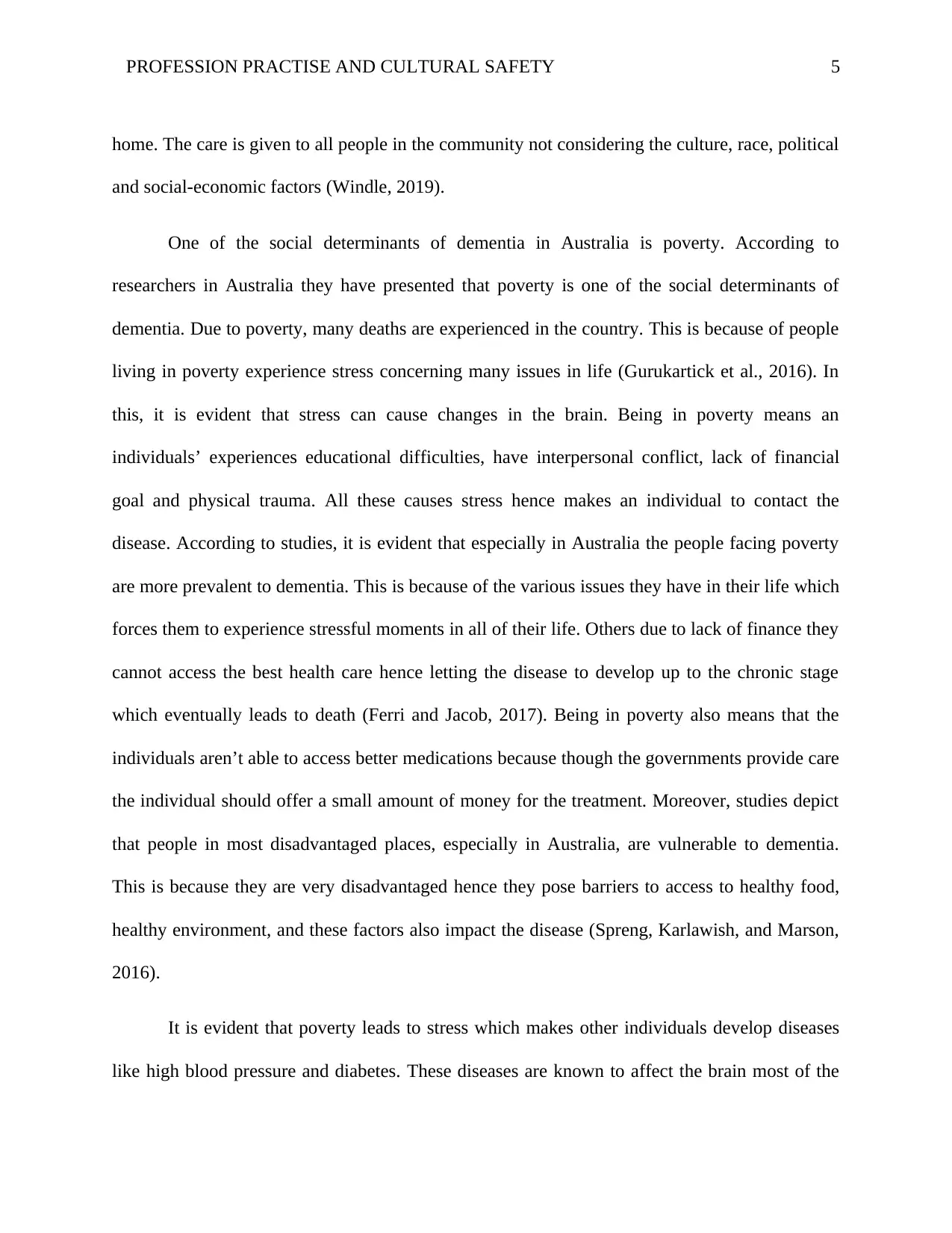
PROFESSION PRACTISE AND CULTURAL SAFETY 5
home. The care is given to all people in the community not considering the culture, race, political
and social-economic factors (Windle, 2019).
One of the social determinants of dementia in Australia is poverty. According to
researchers in Australia they have presented that poverty is one of the social determinants of
dementia. Due to poverty, many deaths are experienced in the country. This is because of people
living in poverty experience stress concerning many issues in life (Gurukartick et al., 2016). In
this, it is evident that stress can cause changes in the brain. Being in poverty means an
individuals’ experiences educational difficulties, have interpersonal conflict, lack of financial
goal and physical trauma. All these causes stress hence makes an individual to contact the
disease. According to studies, it is evident that especially in Australia the people facing poverty
are more prevalent to dementia. This is because of the various issues they have in their life which
forces them to experience stressful moments in all of their life. Others due to lack of finance they
cannot access the best health care hence letting the disease to develop up to the chronic stage
which eventually leads to death (Ferri and Jacob, 2017). Being in poverty also means that the
individuals aren’t able to access better medications because though the governments provide care
the individual should offer a small amount of money for the treatment. Moreover, studies depict
that people in most disadvantaged places, especially in Australia, are vulnerable to dementia.
This is because they are very disadvantaged hence they pose barriers to access to healthy food,
healthy environment, and these factors also impact the disease (Spreng, Karlawish, and Marson,
2016).
It is evident that poverty leads to stress which makes other individuals develop diseases
like high blood pressure and diabetes. These diseases are known to affect the brain most of the
home. The care is given to all people in the community not considering the culture, race, political
and social-economic factors (Windle, 2019).
One of the social determinants of dementia in Australia is poverty. According to
researchers in Australia they have presented that poverty is one of the social determinants of
dementia. Due to poverty, many deaths are experienced in the country. This is because of people
living in poverty experience stress concerning many issues in life (Gurukartick et al., 2016). In
this, it is evident that stress can cause changes in the brain. Being in poverty means an
individuals’ experiences educational difficulties, have interpersonal conflict, lack of financial
goal and physical trauma. All these causes stress hence makes an individual to contact the
disease. According to studies, it is evident that especially in Australia the people facing poverty
are more prevalent to dementia. This is because of the various issues they have in their life which
forces them to experience stressful moments in all of their life. Others due to lack of finance they
cannot access the best health care hence letting the disease to develop up to the chronic stage
which eventually leads to death (Ferri and Jacob, 2017). Being in poverty also means that the
individuals aren’t able to access better medications because though the governments provide care
the individual should offer a small amount of money for the treatment. Moreover, studies depict
that people in most disadvantaged places, especially in Australia, are vulnerable to dementia.
This is because they are very disadvantaged hence they pose barriers to access to healthy food,
healthy environment, and these factors also impact the disease (Spreng, Karlawish, and Marson,
2016).
It is evident that poverty leads to stress which makes other individuals develop diseases
like high blood pressure and diabetes. These diseases are known to affect the brain most of the

PROFESSION PRACTISE AND CULTURAL SAFETY 6
time. When the brain is affected it leads to a high risk of contracting dementia. Another factor in
poverty is child upbringing. This means the children who were brought up through poverty are
more prevalent in getting the disease because a good parental and medical care was not well
offered to them. This factor contributes much in that the child grows with stress and hence
eventually when he or she reaches the old age the diseases becomes vulnerable. Poverty also
comes due to social economic factors and also cultural factors (Strazdins, 2016). There some
cultures which have the responsibility of offering care to their neighbours. When in those
cultures these families which are experiencing poverty are well catered for. But in instances
where there is no cultural awareness people can die with their poverty because they will have no
one to offer medical care to them or solve their problems. It is also evident that people living in
poverty stay in harsh environments which are not favourable. These people are more likely to
develop dementia because they have limited access to medical care (Gombai, 2018).
Nursing in Australia is directed by cultural safety and person-centred care. Partnering
with the consumers means that the health care will produce outcomes which are beneficial to the
patients. In these, the nurses understand that they should involve their patients for their own care.
Partnering with consumer’s standards it’s a branch that underpins all other standards required in
the health sectors. For effective partnerships between the patients and the nurses they require the
promotion of self-centred care, education to the clinicians so that they can acquire skills on the
care, integrate the care models to the patients and the nurses, setting up strategies so that the
reported patient outcomes will be positive and having tools which support effective
communication and good decision making (Mete, 2015).
time. When the brain is affected it leads to a high risk of contracting dementia. Another factor in
poverty is child upbringing. This means the children who were brought up through poverty are
more prevalent in getting the disease because a good parental and medical care was not well
offered to them. This factor contributes much in that the child grows with stress and hence
eventually when he or she reaches the old age the diseases becomes vulnerable. Poverty also
comes due to social economic factors and also cultural factors (Strazdins, 2016). There some
cultures which have the responsibility of offering care to their neighbours. When in those
cultures these families which are experiencing poverty are well catered for. But in instances
where there is no cultural awareness people can die with their poverty because they will have no
one to offer medical care to them or solve their problems. It is also evident that people living in
poverty stay in harsh environments which are not favourable. These people are more likely to
develop dementia because they have limited access to medical care (Gombai, 2018).
Nursing in Australia is directed by cultural safety and person-centred care. Partnering
with the consumers means that the health care will produce outcomes which are beneficial to the
patients. In these, the nurses understand that they should involve their patients for their own care.
Partnering with consumer’s standards it’s a branch that underpins all other standards required in
the health sectors. For effective partnerships between the patients and the nurses they require the
promotion of self-centred care, education to the clinicians so that they can acquire skills on the
care, integrate the care models to the patients and the nurses, setting up strategies so that the
reported patient outcomes will be positive and having tools which support effective
communication and good decision making (Mete, 2015).
⊘ This is a preview!⊘
Do you want full access?
Subscribe today to unlock all pages.

Trusted by 1+ million students worldwide
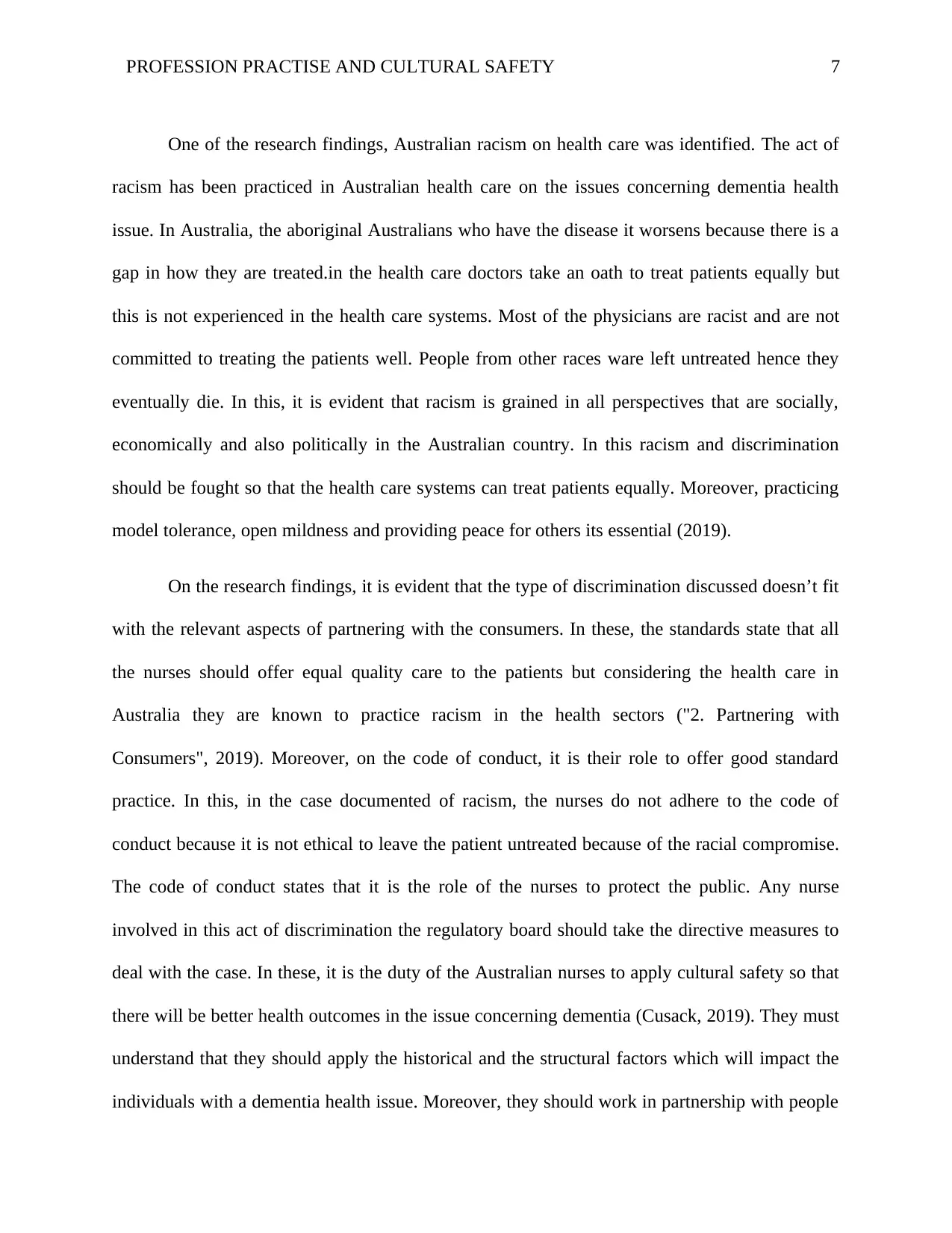
PROFESSION PRACTISE AND CULTURAL SAFETY 7
One of the research findings, Australian racism on health care was identified. The act of
racism has been practiced in Australian health care on the issues concerning dementia health
issue. In Australia, the aboriginal Australians who have the disease it worsens because there is a
gap in how they are treated.in the health care doctors take an oath to treat patients equally but
this is not experienced in the health care systems. Most of the physicians are racist and are not
committed to treating the patients well. People from other races ware left untreated hence they
eventually die. In this, it is evident that racism is grained in all perspectives that are socially,
economically and also politically in the Australian country. In this racism and discrimination
should be fought so that the health care systems can treat patients equally. Moreover, practicing
model tolerance, open mildness and providing peace for others its essential (2019).
On the research findings, it is evident that the type of discrimination discussed doesn’t fit
with the relevant aspects of partnering with the consumers. In these, the standards state that all
the nurses should offer equal quality care to the patients but considering the health care in
Australia they are known to practice racism in the health sectors ("2. Partnering with
Consumers", 2019). Moreover, on the code of conduct, it is their role to offer good standard
practice. In this, in the case documented of racism, the nurses do not adhere to the code of
conduct because it is not ethical to leave the patient untreated because of the racial compromise.
The code of conduct states that it is the role of the nurses to protect the public. Any nurse
involved in this act of discrimination the regulatory board should take the directive measures to
deal with the case. In these, it is the duty of the Australian nurses to apply cultural safety so that
there will be better health outcomes in the issue concerning dementia (Cusack, 2019). They must
understand that they should apply the historical and the structural factors which will impact the
individuals with a dementia health issue. Moreover, they should work in partnership with people
One of the research findings, Australian racism on health care was identified. The act of
racism has been practiced in Australian health care on the issues concerning dementia health
issue. In Australia, the aboriginal Australians who have the disease it worsens because there is a
gap in how they are treated.in the health care doctors take an oath to treat patients equally but
this is not experienced in the health care systems. Most of the physicians are racist and are not
committed to treating the patients well. People from other races ware left untreated hence they
eventually die. In this, it is evident that racism is grained in all perspectives that are socially,
economically and also politically in the Australian country. In this racism and discrimination
should be fought so that the health care systems can treat patients equally. Moreover, practicing
model tolerance, open mildness and providing peace for others its essential (2019).
On the research findings, it is evident that the type of discrimination discussed doesn’t fit
with the relevant aspects of partnering with the consumers. In these, the standards state that all
the nurses should offer equal quality care to the patients but considering the health care in
Australia they are known to practice racism in the health sectors ("2. Partnering with
Consumers", 2019). Moreover, on the code of conduct, it is their role to offer good standard
practice. In this, in the case documented of racism, the nurses do not adhere to the code of
conduct because it is not ethical to leave the patient untreated because of the racial compromise.
The code of conduct states that it is the role of the nurses to protect the public. Any nurse
involved in this act of discrimination the regulatory board should take the directive measures to
deal with the case. In these, it is the duty of the Australian nurses to apply cultural safety so that
there will be better health outcomes in the issue concerning dementia (Cusack, 2019). They must
understand that they should apply the historical and the structural factors which will impact the
individuals with a dementia health issue. Moreover, they should work in partnership with people
Paraphrase This Document
Need a fresh take? Get an instant paraphrase of this document with our AI Paraphraser

PROFESSION PRACTISE AND CULTURAL SAFETY 8
and communities and hence dealing away with racism. The material also doesn’t fit in the code
of ethics as it is wrong to practice racism in any area. The code of ethics states that it a
professional behaviour of not considering ethnicity group of any individual when offering
treatment care.
Conclusion
The dementia health issue is the second disease which causes deaths in Australia. The
people affected with this health issue are the aged people. According to studies women are more
vulnerable to disease than the males. The types of health delivery offered to the patients is the
primary care which involves screening the individuals so that early treatment can be offered.
Types of health care delivery offered in Australia health care includes the institutionalization
care and community-based care. All this care delivery helps to improve value in the essence of
treating the disease. The main social determinant of dementia health issue is poverty in that due
to the stress experienced by these people they are more vulnerable to get the disease than rich
people. It is also evident that these people lack financial stability to access to health cares. One of
the discrimination factor related to dementia is racism and in this, it depicts that according to the
nursing standards the following aspects are not do not fit with what is practiced. These include
partnering with the consumers, culturally safe and respectful practice and the code of ethics.
and communities and hence dealing away with racism. The material also doesn’t fit in the code
of ethics as it is wrong to practice racism in any area. The code of ethics states that it a
professional behaviour of not considering ethnicity group of any individual when offering
treatment care.
Conclusion
The dementia health issue is the second disease which causes deaths in Australia. The
people affected with this health issue are the aged people. According to studies women are more
vulnerable to disease than the males. The types of health delivery offered to the patients is the
primary care which involves screening the individuals so that early treatment can be offered.
Types of health care delivery offered in Australia health care includes the institutionalization
care and community-based care. All this care delivery helps to improve value in the essence of
treating the disease. The main social determinant of dementia health issue is poverty in that due
to the stress experienced by these people they are more vulnerable to get the disease than rich
people. It is also evident that these people lack financial stability to access to health cares. One of
the discrimination factor related to dementia is racism and in this, it depicts that according to the
nursing standards the following aspects are not do not fit with what is practiced. These include
partnering with the consumers, culturally safe and respectful practice and the code of ethics.
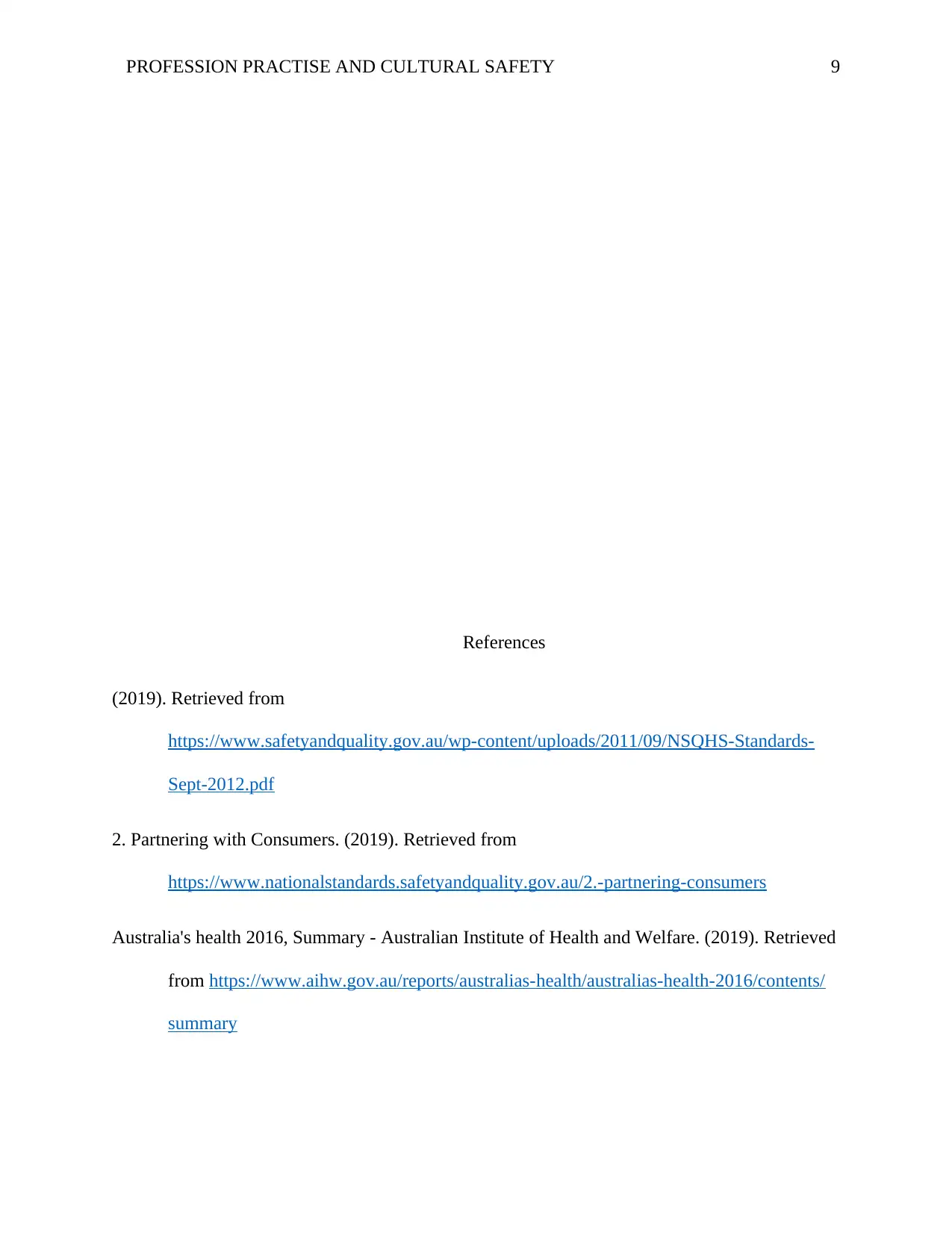
PROFESSION PRACTISE AND CULTURAL SAFETY 9
References
(2019). Retrieved from
https://www.safetyandquality.gov.au/wp-content/uploads/2011/09/NSQHS-Standards-
Sept-2012.pdf
2. Partnering with Consumers. (2019). Retrieved from
https://www.nationalstandards.safetyandquality.gov.au/2.-partnering-consumers
Australia's health 2016, Summary - Australian Institute of Health and Welfare. (2019). Retrieved
from https://www.aihw.gov.au/reports/australias-health/australias-health-2016/contents/
summary
References
(2019). Retrieved from
https://www.safetyandquality.gov.au/wp-content/uploads/2011/09/NSQHS-Standards-
Sept-2012.pdf
2. Partnering with Consumers. (2019). Retrieved from
https://www.nationalstandards.safetyandquality.gov.au/2.-partnering-consumers
Australia's health 2016, Summary - Australian Institute of Health and Welfare. (2019). Retrieved
from https://www.aihw.gov.au/reports/australias-health/australias-health-2016/contents/
summary
⊘ This is a preview!⊘
Do you want full access?
Subscribe today to unlock all pages.

Trusted by 1+ million students worldwide
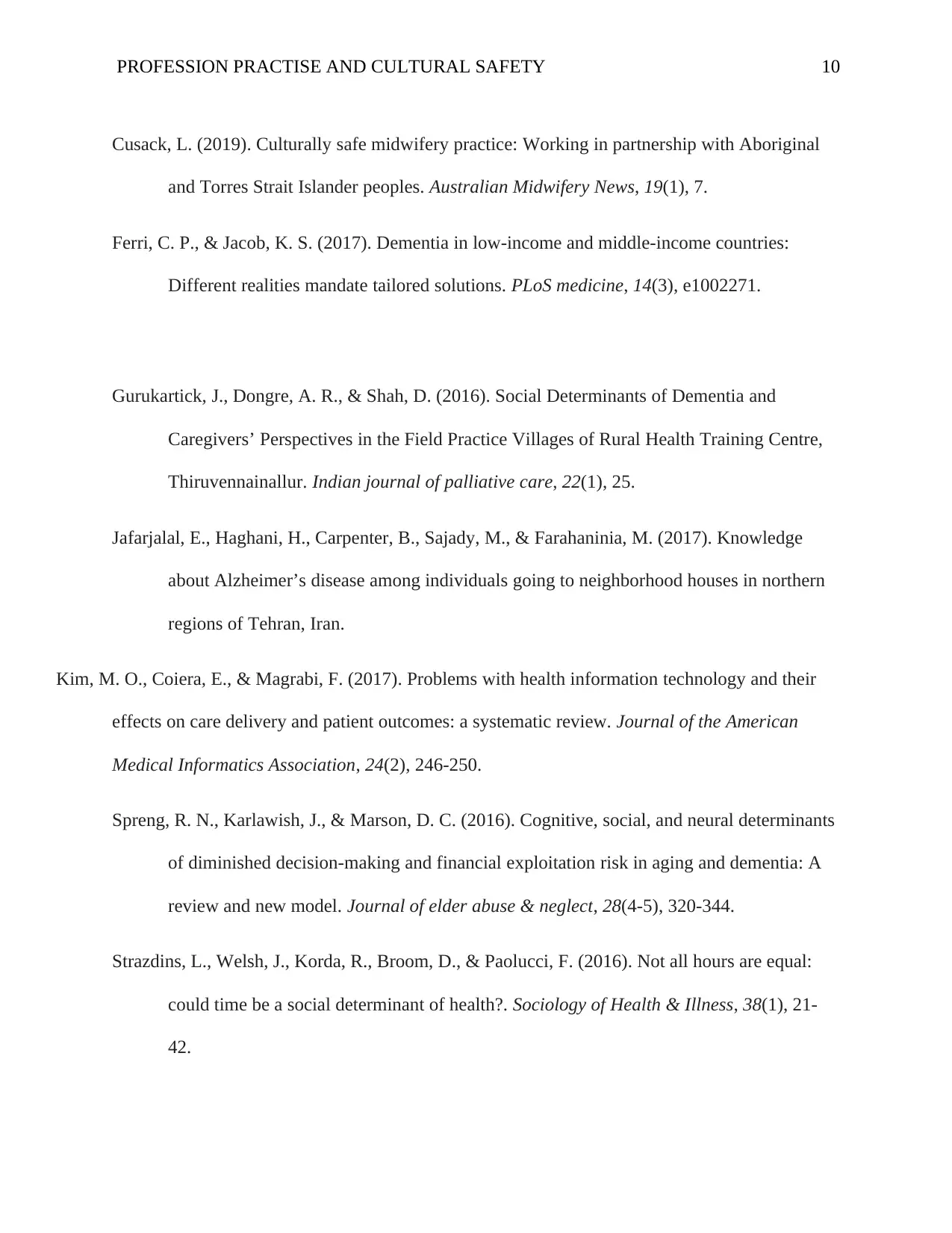
PROFESSION PRACTISE AND CULTURAL SAFETY 10
Cusack, L. (2019). Culturally safe midwifery practice: Working in partnership with Aboriginal
and Torres Strait Islander peoples. Australian Midwifery News, 19(1), 7.
Ferri, C. P., & Jacob, K. S. (2017). Dementia in low-income and middle-income countries:
Different realities mandate tailored solutions. PLoS medicine, 14(3), e1002271.
Gurukartick, J., Dongre, A. R., & Shah, D. (2016). Social Determinants of Dementia and
Caregivers’ Perspectives in the Field Practice Villages of Rural Health Training Centre,
Thiruvennainallur. Indian journal of palliative care, 22(1), 25.
Jafarjalal, E., Haghani, H., Carpenter, B., Sajady, M., & Farahaninia, M. (2017). Knowledge
about Alzheimer’s disease among individuals going to neighborhood houses in northern
regions of Tehran, Iran.
Kim, M. O., Coiera, E., & Magrabi, F. (2017). Problems with health information technology and their
effects on care delivery and patient outcomes: a systematic review. Journal of the American
Medical Informatics Association, 24(2), 246-250.
Spreng, R. N., Karlawish, J., & Marson, D. C. (2016). Cognitive, social, and neural determinants
of diminished decision-making and financial exploitation risk in aging and dementia: A
review and new model. Journal of elder abuse & neglect, 28(4-5), 320-344.
Strazdins, L., Welsh, J., Korda, R., Broom, D., & Paolucci, F. (2016). Not all hours are equal:
could time be a social determinant of health?. Sociology of Health & Illness, 38(1), 21-
42.
Cusack, L. (2019). Culturally safe midwifery practice: Working in partnership with Aboriginal
and Torres Strait Islander peoples. Australian Midwifery News, 19(1), 7.
Ferri, C. P., & Jacob, K. S. (2017). Dementia in low-income and middle-income countries:
Different realities mandate tailored solutions. PLoS medicine, 14(3), e1002271.
Gurukartick, J., Dongre, A. R., & Shah, D. (2016). Social Determinants of Dementia and
Caregivers’ Perspectives in the Field Practice Villages of Rural Health Training Centre,
Thiruvennainallur. Indian journal of palliative care, 22(1), 25.
Jafarjalal, E., Haghani, H., Carpenter, B., Sajady, M., & Farahaninia, M. (2017). Knowledge
about Alzheimer’s disease among individuals going to neighborhood houses in northern
regions of Tehran, Iran.
Kim, M. O., Coiera, E., & Magrabi, F. (2017). Problems with health information technology and their
effects on care delivery and patient outcomes: a systematic review. Journal of the American
Medical Informatics Association, 24(2), 246-250.
Spreng, R. N., Karlawish, J., & Marson, D. C. (2016). Cognitive, social, and neural determinants
of diminished decision-making and financial exploitation risk in aging and dementia: A
review and new model. Journal of elder abuse & neglect, 28(4-5), 320-344.
Strazdins, L., Welsh, J., Korda, R., Broom, D., & Paolucci, F. (2016). Not all hours are equal:
could time be a social determinant of health?. Sociology of Health & Illness, 38(1), 21-
42.
Paraphrase This Document
Need a fresh take? Get an instant paraphrase of this document with our AI Paraphraser

PROFESSION PRACTISE AND CULTURAL SAFETY 11
Wakerman, J., Humphreys, J., Wells, R., Kuipers, P., Entwistle, P., & Jones, J. (2017). A systematic
review of primary health care delivery models in rural and remote Australia 1993-2006.
Windle, G., Algar-Skaife, K., Caulfield, M., Pickering-Jones, L., Killick, J., Zeilig, H., &
Tischler, V. (2019). Enhancing communication between dementia care staff and their
residents: an arts-inspired intervention. Aging & mental health, 1-10.
Kenning, G. (2016). Viewing art brings ‘in the moment’pleasure. Australian Journal of
Dementia Care.
Gombai, A. (2018). Deviation from a Balanced Time Perspective among Older Adults in
Relation to Global Cognitive Functioning.
Mete, L., SARIKAYA, Ö., & EROL, A. (2015). The Relationship of Deficit Syndrome with
Clinical Symptoms, Summer Births and Heritability in Patients with
Schizophrenia. Turkish Journal of Psychiatry, 26(4).
Edberg, A. K., Bird, M., Richards, D. A., Woods, R., Keeley, P., & Davis-Quarrell, V. (2018).
Strain in nursing care of people with dementia: nurses’ experience in Australia, Sweden
and United Kingdom. Aging and Mental Health, 12(2), 236-243.
Wakerman, J., Humphreys, J., Wells, R., Kuipers, P., Entwistle, P., & Jones, J. (2017). A systematic
review of primary health care delivery models in rural and remote Australia 1993-2006.
Windle, G., Algar-Skaife, K., Caulfield, M., Pickering-Jones, L., Killick, J., Zeilig, H., &
Tischler, V. (2019). Enhancing communication between dementia care staff and their
residents: an arts-inspired intervention. Aging & mental health, 1-10.
Kenning, G. (2016). Viewing art brings ‘in the moment’pleasure. Australian Journal of
Dementia Care.
Gombai, A. (2018). Deviation from a Balanced Time Perspective among Older Adults in
Relation to Global Cognitive Functioning.
Mete, L., SARIKAYA, Ö., & EROL, A. (2015). The Relationship of Deficit Syndrome with
Clinical Symptoms, Summer Births and Heritability in Patients with
Schizophrenia. Turkish Journal of Psychiatry, 26(4).
Edberg, A. K., Bird, M., Richards, D. A., Woods, R., Keeley, P., & Davis-Quarrell, V. (2018).
Strain in nursing care of people with dementia: nurses’ experience in Australia, Sweden
and United Kingdom. Aging and Mental Health, 12(2), 236-243.
1 out of 11
Related Documents
Your All-in-One AI-Powered Toolkit for Academic Success.
+13062052269
info@desklib.com
Available 24*7 on WhatsApp / Email
![[object Object]](/_next/static/media/star-bottom.7253800d.svg)
Unlock your academic potential
Copyright © 2020–2025 A2Z Services. All Rights Reserved. Developed and managed by ZUCOL.





